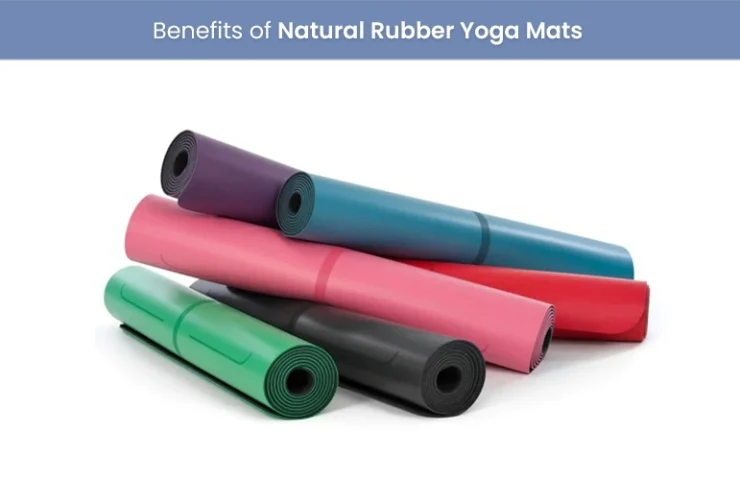As the popularity of yoga continues to soar, so does the importance of choosing the right equipment. One of the most crucial decisions a yogi faces is selecting the perfect yoga mat. With a vast array of materials and brands available, navigating the world of yoga mats can be overwhelming. This article delves into the two most popular mat materials – cotton and synthetics – to help you make an informed choice that aligns with your practice and values.
The growing emphasis on eco-conscious living has significantly impacted yoga practices. Many yogis are increasingly opting for sustainable and eco-friendly options, extending their mindfulness beyond the poses themselves. The material your yoga mat is made from is a vital consideration in this regard. Let’s explore the unique characteristics of cotton and synthetic yoga mats to guide you towards the ideal choice for your needs.
What are Cotton Yoga Mats?
Cotton yoga mats are crafted from natural cotton fiber, often organic cotton for a more sustainable option. They are known for their soft and absorbent texture, providing a comfortable and natural feel during practice.
Benefits of Cotton Yoga Mats:
- Breathability: Cotton is a naturally breathable material, allowing air to circulate and preventing moisture build-up during sweaty practices. This can significantly enhance comfort and hygiene, especially for individuals who practice hot yoga or Vinyasa flows.
- Eco-friendliness: Organic cotton mats are a more sustainable choice compared to synthetic materials. The production of organic cotton minimizes the use of harmful pesticides and fertilizers, reducing its environmental impact.
- Biodegradable: Cotton is a biodegradable material, meaning it decomposes naturally at the end of its lifespan. This makes cotton mats an eco-friendlier option compared to synthetic mats that may take hundreds of years to break down in landfills.
- Softness and Comfort: Cotton mats offer a gentle and comfortable surface for practice. This can be particularly beneficial for individuals with sensitive skin or those who prefer a softer feel underfoot.
Considerations for Cotton Mats:
- Grip: Cotton mats may not offer the same level of grip as synthetic mats, especially when wet. This can be a concern for practitioners who sweat heavily or perform dynamic flows. Using a yoga towel or opting for a cotton mat with a textured surface can help improve grip.
- Absorbency: While breathability is a benefit, cotton absorbs moisture, which can lead to faster wear and tear. Regular cleaning and drying are essential to maintain hygiene and prevent the growth of mold or mildew.
- Maintenance: Cotton mats typically require more frequent cleaning and drying compared to synthetic mats. Machine washing and drying may be possible for some mats, but always follow the manufacturer’s care instructions.
What are Synthetic Yoga Mats?
Synthetic yoga mats are typically made from PVC (polyvinyl chloride) or TPE (thermoplastic elastomer). They are known for their durability, ease of maintenance, and often provide excellent grip.
Benefits of Synthetic Mats:
- Durability: Synthetic mats are generally more durable than cotton mats. They can withstand regular use and are less prone to wear and tear.
- Ease of Maintenance: Synthetic mats are typically easier to clean and maintain. They often wipe clean with a damp cloth or mild disinfectant spray.
- Grip: Synthetic mats, especially those made of TPE, often provide excellent grip, even when wet. This can be advantageous for practitioners who sweat heavily or perform dynamic yoga styles.
- Variety of Options: Synthetic mats come in a wider variety of thicknesses, colours, and textures compared to cotton mats. This allows for more personalized selection based on individual preferences and practice styles.
Considerations for Synthetic Mats:
- Sustainability: PVC mats are not eco-friendly, and some TPE options may not be biodegradable. Look for recyclable TPE mats or those made from recycled materials for a more sustainable choice.
- Odour: Some synthetic mats, particularly PVC mats, may have a chemical odour when new. This odour usually dissipates with time and proper airing.
- Biodegradability: Not all synthetic materials are biodegradable. Opt for TPE mats that are labelled. as biodegradable for a more eco-conscious option.
Cotton Yoga Mats vs Synthetic Yoga Mats: A Comparison Table
Learn the differences between cotton yoga mats and synthetic yoga mats to find the perfect one for your practice.
| Feature | Cotton Yoga Mats | Synthetic Yoga Mats |
| Material | Natural cotton fibres | PVC, TPE, or other synthetic materials |
| Benefits | Breathable, eco-friendly, biodegradable, soft and comfortable | Durable, easy to maintain, good grip (especially TPE), variety of options |
| Considerations | Lower grip (especially when wet), absorbent, requires more frequent cleaning and drying | May not be eco-friendly (PVC), potential odor (especially new mats), not all are biodegradable |
Choosing the Right Mat:
The ideal yoga mat material depends on your individual needs and preferences. Consider the following factors when making your choice:
- Practice Style: If you practice hot yoga or Vinyasa flows, a synthetic mat with excellent grip is essential. For gentler styles like Hatha or restorative yoga, a cotton mat may be more comfortable.
- Environmental Impact: If sustainability is a priority, opt for an organic cotton or recycled TPE mat.
- Budget: Cotton mats are generally more affordable than high-quality synthetic mats.
- Personal Preference: Ultimately, the best way to choose a mat is to try different options and see what feels most comfortable for you.
By carefully considering these factors, you can select the perfect yoga mat to enhance your practice and contribute to a more sustainable lifestyle.
Conclusion
The choice between cotton and synthetic yoga mats ultimately depends on your individual needs and preferences. Cotton mats offer a natural, eco-friendly option with excellent breathability and comfort. However, they may require more maintenance and may not provide the same level of grip as synthetic mats. Synthetic mats, particularly those made from TPE, offer durability, ease of maintenance, and excellent grip. However, not all synthetic materials are eco-friendly, and some may have a chemical odor.
When selecting a yoga mat, consider your practice style, environmental values, budget, and personal preferences. By carefully evaluating these factors, you can find the perfect mat to enhance your yoga experience and contribute to a more sustainable lifestyle.
Remember, the most important aspect is to choose a mat that inspires you to practice regularly and enjoy the benefits of yoga.






0 Comments for “Cotton Yoga Mats vs Synthetic Yoga Mats: Finding the Perfect Fit for Your Practice”